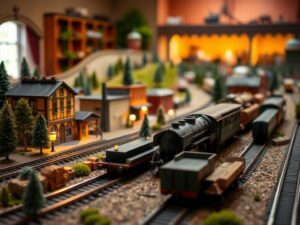Best Lubricants for HO Scale Trains and Tracks
Best Lubricants for HO Scale Trains and Tracks
Best Lubricants for HO Scale Trains: A Comprehensive Guide for Smooth Riding
Hey fellow railfans! Welcome back to the blog! Today, we’re tackling a topic crucial to ensuring your HO scale trains run smoothly and look their best â lubrication! It might seem like a simple thing, but choosing the right lubricants can make a world of difference in the performance and longevity of your model railroad setup. Whether youâre a seasoned enthusiast or just starting your modeling journey, this guide will equip you with everything you need to know about keeping those tiny engines humming along.
Why Lubrication Matters for HO Scale Trains:
In the miniature world of HO scale, even tiny amounts of friction can significantly impact performance. Over time, friction generates heat and wear on delicate components like axles, gears, and wheels.
Proper lubrication does several key things:
- Reduces Friction: It acts as a thin film between moving parts, minimizing resistance and allowing for smoother operation.
- Extends Component Lifespan: By reducing friction-induced wear and tear, lubricants help keep your locomotives and rolling stock in top shape for years to come.
- Minimizes Noise: Less friction translates into quieter train operations, making your model railroad experience more enjoyable.
Different Lubricants, Different Needs:
Not all lubricants are created equal! Different applications demand different types of lubrication:
1. Locomotive Wheels:
The heart of a locomotive is its wheels, and keeping them rolling smoothly is paramount. For this purpose, we typically use specialized dry lubes:
-
Silicone Spray Lubricants: These sprays offer a good balance between lubricity, resistance to dust buildup, and non-staining properties. They’re widely available at hobby stores and work great for light lubrication.
-
White Lithium Grease: This thick grease is best used sparingly on heavily worn axles or when running trains in dusty environments. Apply it very lightly with a toothpick or small brush to avoid build-up.
- Wax-Based Lube Sticks: These are great for quickly touching up worn areas, offering concentrated lubrication where you need it most.
2. Truck Axles and Gearboxes:
These areas benefit from a thicker lubricant that can withstand heavier loads and resist flinging out:
- Chassis Grease: This high-quality lithium grease provides excellent protection against wear and tear. Apply sparingly with a small brush or tool, focusing on the points where the axle meets the truck assembly and within gearboxes.
3. Slide Bars and Other Moving Parts:
To keep your model railroad components gliding smoothly, use these types of lubrication:
- Graphite Powder Lubricant: This dry powder works wonders on slide bars by reducing friction and minimizing wear. Apply a light dusting using a soft brush or q-tip.
- Light Oil Lubricants: Use very sparingly to lubricate bearings or other small parts where silicone or grease might be excessive. Avoid using oil in areas that could come into contact with your track, as it can attract dirt and cause track damage.
Essential Tips for Proper Lubrication:
- Clean Before You Lube: Remove any dust, debris, or old lubricant before applying a fresh coat. A soft brush and some isopropyl alcohol can do wonders!
- Apply Lightly: Remember, less is often more when it comes to lubrication. Over-lubrication can actually lead to problems by attracting dirt and grime. Start with small amounts and gradually add more if needed.
- Specific Lubricants for Specific Needs: Different manufacturers may recommend different lubricants, so always refer to the instruction manual for your model trains.
- Don’t Use Motor Oil: Though it might seem like a handy option, motor oil is too thick and viscous for HO scale applications. It can leave a sticky residue that attracts dirt and damage sensitive parts.
Troubleshooting Tips:
If youâre experiencing issues with your train running smoothly:
- Check Your Track Cleaning: A clean track is essential! Use track cleaning cars regularly or rub down your tracks gently with rubbing alcohol on a cotton swab.
- Inspect for Overly Lubricated Areas: Excessive lubrication can attract dirt and debris, hindering movement. Gently remove any excess lube using a dry cloth or toothpick.
- Adjust Your Track Alignment: Even slight misalignments can cause trains to derail or run unevenly.
Beyond the Basics: Advanced Lubrication Techniques:
For the true enthusiasts, here are some additional tips:
- Precision Dispensers: Invest in a small syringe or pipette with a fine tip for accurate application of lubricants like silicone spray and white lithium grease.
- Dry Lube Alternatives: Explore options like graphite powder or ceramic bearings for extended lubrication periods and enhanced wear resistance.
Keeping Your Trains Running Like New:
Regular lubrication is essential for keeping your HO scale trains running smoothly and looking their best. Remember, a little attention goes a long way in extending the lifespan of your beloved models and ensuring many happy years of model railroading!
Feel free to leave comments below if you have any specific questions about lubes or anything else related to HO scale model trains. We’re all part of this amazing community!




